Marshall Island serves as resting place for WWII battle vehicles
The island of Roi-Namur is located in the northern part of Kwajalein Atoll, one of the many volcanic islands and coral atolls comprising the Republic of the Marshall Islands. Situated in the Pacific Ocean between Hawaii and the Philippines, in January 1944, the island was the site of a World War II battle and a dumping ground for an assortment of aircraft and other military equipment that now reside on the adjacent sea floor.
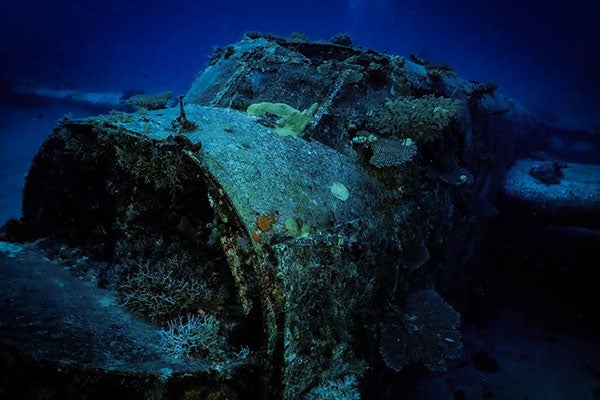
Artifacts dumped in the deep waters of Kwajalein Lagoon, off the island of Roi-Namur, include airplanes, ships, trucks and jeeps. (Contributed photos and 3-D imagery)
The Battle of Roi-Namur was an early step in the American island-hopping campaign and was considered a strategically important location for staging subsequent invasions. Once secured, damaged aircraft and other vehicles were quickly cleared from the island and dumped in the deep waters of Kwajalein Lagoon to allow military personnel to rebuild the airstrip and use the island as an operational base.
East Carolina University’s Dr. Jason Raupp, assistant professor in the Department of History’s Program in Maritime Studies, led a team that recently conducted research at the site.
Funded through a 2019 American Battlefield Protection Program grant, the research was completed with the assistance of the U.S. Army Garrison Kwajalein Atoll, the Kwajalein MIA Project and local researcher Daniel Gunter. Although the project was delayed due to travel restrictions related to the COVID-19 pandemic, it wrapped up earlier this year with the team’s final report.
“There’s a lot that we haven’t had a chance to dig into yet,” Raupp said. “We hope to find follow-up funding to do more research both at the site and in archives.”
The small team of three — Raupp, ECU history alumnus Dr. Dominic Bush (Ph.D. ’24) and program associate Shawn Arnold — conducted scuba operations to assess the types of planes and other equipment at the site. The team took underwater videos and then used the imagery to create 3-D photo models of the various aircraft and vehicles.
“It’s crazy, because you can see how planes were pushed off of barges, and many landed nose-first in the sand and remain in that position,” Raupp said.
According to Raupp, Gunter refers to one such site as Planehenge, a nod to England’s Stonehenge.
Raupp’s interest in the area was piqued in 2018, when he heard about the site while undertaking WWII-related research at another location in the Marshall Islands. Although the island is protected by the National Park Service’s National Register of Historic Places, the boundaries do not include artifacts and sites situated in the water.
“It is important for those sites to be properly documented because they are exceptionally intact and can provide a great deal of information,” Raupp said.
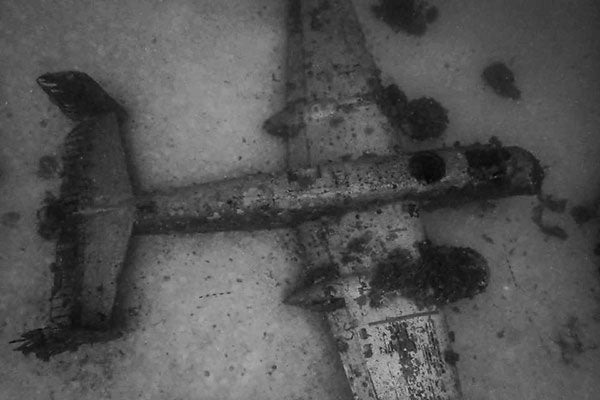
Intact artifacts off the island of Roi-Namur provide a wealth of information to ECU staff and student researchers.
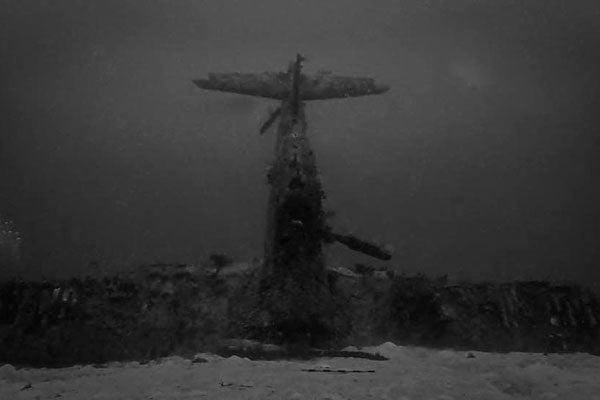
One site, where planes landed nose-first on the sea floor, is referred to as Planehenge by a local researcher.
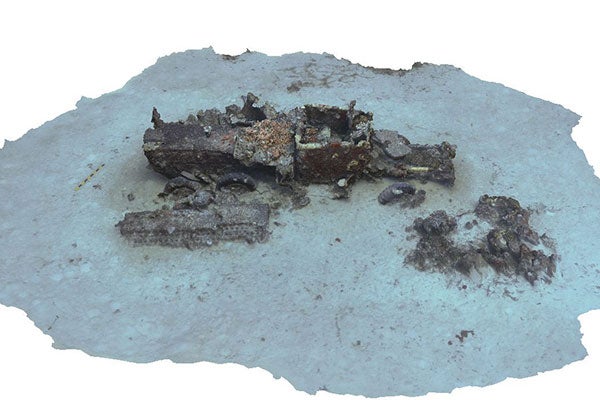
The research team took underwater videos and then used the imagery to create 3-D photo models of the various aircraft and vehicles, including this truck.
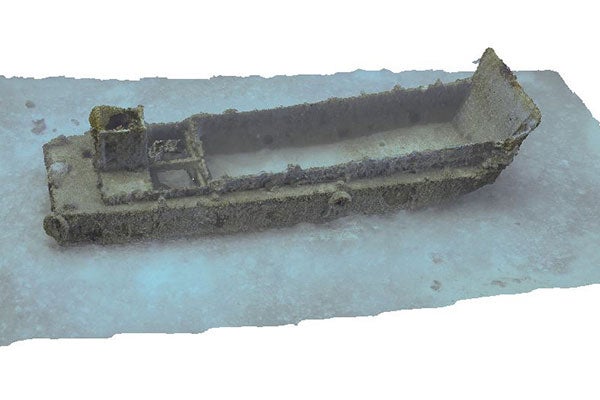
The research team took underwater videos and then used the imagery to create 3-D photo models of the various aircraft and vehicles, including this armored troop carrier.

The research team took underwater videos and then used the imagery to create 3-D photo models of the various aircraft and vehicles, including this nearly fully intact airplane resting on its belly.
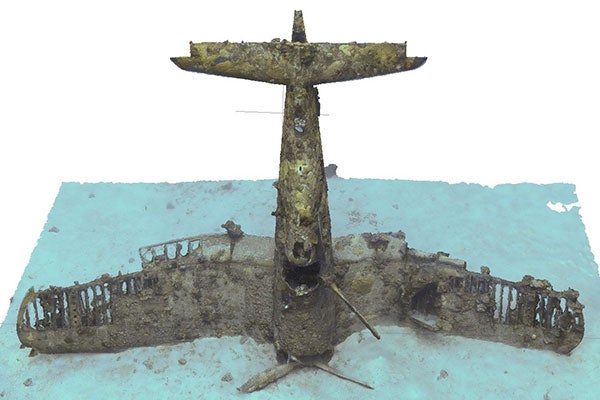
The research team took underwater videos and then used the imagery to create 3-D photo models of the various aircraft and vehicles, including this airplane standing on its nose.
ECU graduate students Bush, Dayan Weller (MA in Maritime Studies, ’24), Dominic Fargnoli (MA in Maritime Studies, ’23) and Jim Fowler (current student in the MA in maritime studies program), all helped to analyze data and conduct historical research. In addition to assisting with the preparation of the final report, Fargnoli used geospatial data recovered through the project as part of his master’s thesis research.
“This was a great example of providing students opportunities to gain practical experience in all phases of research,” Raupp said.
In the report, Raupp’s team wrote, “A 2011 publication by the Republic of Marshall Islands (RMI) Historic Preservation Office noted that due to the vast oceanic expanse of the RMI and its significant marine resources, inventory of submerged cultural resources remains difficult and largely incomplete.”
Therefore, the team aimed to conduct the first formal archaeological survey of the submerged battlefield and associated WWII-era cultural resources at Roi-Namur.
“We also wanted to move forward with understanding the battlefield and how those dumped aircraft formed part of a larger battlescape,” Raupp said. “All the clean-up efforts were components of a larger strategy of an island-hopping campaign that went throughout the South Pacific and up through the Mariana Islands.”
“The U.S. knew they needed to secure Kwajalein Atoll, and in particular the island of Roi-Namur, as a staging point for further assaults on other island groups in the progress toward accessing the Japanese mainland,” he said.
Historical references estimate more than 100 planes were dumped after the battle, including one Mitsubishi A6M “Zero,” which Raupp thinks was bombed on the island, not in the air. The Japanese Zero, as he referred to the plane, is a long-range carrier-based fighter aircraft formerly manufactured by Mitsubishi Aircraft Company, a part of Mitsubishi Heavy Industries. It was operated by the Imperial Japanese Navy from 1940 to 1945.
Local divers assisted Raupp’s team with diving and survey operations at eight sites. However, the locations of three Japanese ships bombed during the battle, as well as approximately 60 aircraft, multiple landing craft, trucks and jeeps dumped during the post-battle cleanup, have been popular dive destinations for locals for decades.
“The baseline data collected through this project is but a start to what should be a much more comprehensive study,” the team wrote. “The sheer number of aircraft, shipwrecks and smaller military vehicles situated in the Kwajalein Lagoon near Roi-Namur is staggering. But the fact that almost all of them are incredibly well-preserved after 80 years is reason enough to recommend a much more comprehensive study of this area, as it indubitably has world heritage value.”
“It’s a truly unique and remarkable place,” Raupp said.
Since its establishment in 1981, East Carolina University’s graduate program in Maritime Studies has blossomed into one of the world’s leading academic underwater archaeology programs. It is characterized by hands-on underwater training, primary document historical research and other practical skills such as remote sensing and grant writing. This unique program is open to applicants with baccalaureate degrees from a variety of academic disciplines, including anthropology, archaeology, biology, business, English and history, and has an excellent track record of job placement for graduates. Learn more at the Maritime Studies website.